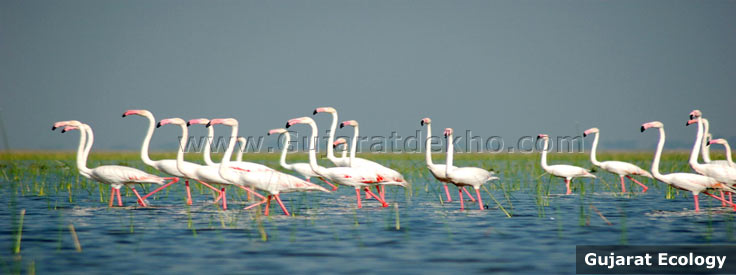Home
Gujarat Ecology
Gujarat Ecology
The Gujarat's diverse environment include the dry grasslands and scrub forests in Kutch and Saurashtra, amazing salt flats in the Rann of Kutch, lovely deciduous forests in the eastern border of the state and rivers such as Sabarmati, Narmada, Mahi and Tapi. An abundance wetlands spread across the Gujarat attracts countless migratory birds and a long coastline nurtures large marine ecosystems, which includes estuaries, reefs, sandy coasts and tidal mudflats. In the coastal areas of the Saurashtra peninsula, there are also mangrove forests and coral reefs, which are necessary to supporting marine biodiversity. This rich Gujarat Ecology (ecosystem) nurtures around 2,700 species of animals and somewhat 4,300 species of plants. The following section gives detailed information about Gujarat Ecology such as Gujarat Challenges, wetlands, forests, ecotourism, etc.
Birds in Gujarat
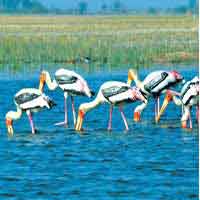 The Gujarat geographically lies on the migratory route of thousands of bird species, making it a birdwatcher's heaven. The annual southwest monsoon brings seriously needed rains that refill water bodies and regenerate grasslands, creating perfect habitats for various Birds in Gujarat such as the pelican, flamingo, goose, stork ibis, duck, bustard, Sarus crane and florican. A substantial population of the world's Common and Demoiselle cranes spend their winter in Gujarat and about half the world's Lesser florican, an endangered species, breeds in the grasslands of Saurashtra, Kachhch and Dahod districts during the monsoon. The endangered Greater-spotted and Imperial eagles also migrate to Gujarat during winter. The only known breeding area of the Lesser flamingo is found in the Rann of Kutch. Birds of Gujarat are one of the important factors of Gujarat Ecology.
The Gujarat geographically lies on the migratory route of thousands of bird species, making it a birdwatcher's heaven. The annual southwest monsoon brings seriously needed rains that refill water bodies and regenerate grasslands, creating perfect habitats for various Birds in Gujarat such as the pelican, flamingo, goose, stork ibis, duck, bustard, Sarus crane and florican. A substantial population of the world's Common and Demoiselle cranes spend their winter in Gujarat and about half the world's Lesser florican, an endangered species, breeds in the grasslands of Saurashtra, Kachhch and Dahod districts during the monsoon. The endangered Greater-spotted and Imperial eagles also migrate to Gujarat during winter. The only known breeding area of the Lesser flamingo is found in the Rann of Kutch. Birds of Gujarat are one of the important factors of Gujarat Ecology.
Forests in Gujarat
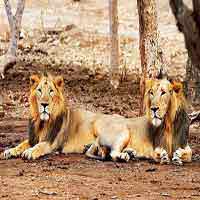 The Forests in Gujarat cover about 7.7 percent of the total geographic area. The Forests in Gujarat are mostly concentrated along Gujarat's eastern border and the hilly portion of Saurashtra. More than 60 percent of the population of Gujarat lives in rural areas and depend directly on forest resources such as fodder, timber and wood for their daily requirements. This has confronted the government's ability to maintain and regenerate forest areas. The State Department of Forestry encourage a Social Forestry Program, encouraging citizens and organizations to plant trees on non-forested land to make the state green and eco-friendly.
The Forests in Gujarat cover about 7.7 percent of the total geographic area. The Forests in Gujarat are mostly concentrated along Gujarat's eastern border and the hilly portion of Saurashtra. More than 60 percent of the population of Gujarat lives in rural areas and depend directly on forest resources such as fodder, timber and wood for their daily requirements. This has confronted the government's ability to maintain and regenerate forest areas. The State Department of Forestry encourage a Social Forestry Program, encouraging citizens and organizations to plant trees on non-forested land to make the state green and eco-friendly.
Wetlands in Gujarat
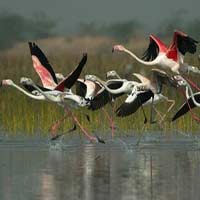 The Wetlands in Gujarat occupy about 27,000 square kilometers of Gujarat. These Wetlands in Gujarat are low-lying ecosystems have water tables near the surface and become a mating and feeding grounds for many animal and plant species. Wetlands in Gujarat also help to manage the water cycle, recharge ground water, filter the water supply, stop soil erosion and absorb floodwaters. Wetlands of Gujarat are also one of the important factors of Gujarat Ecology.
The Wetlands in Gujarat occupy about 27,000 square kilometers of Gujarat. These Wetlands in Gujarat are low-lying ecosystems have water tables near the surface and become a mating and feeding grounds for many animal and plant species. Wetlands in Gujarat also help to manage the water cycle, recharge ground water, filter the water supply, stop soil erosion and absorb floodwaters. Wetlands of Gujarat are also one of the important factors of Gujarat Ecology.
Ecotourism in Gujarat
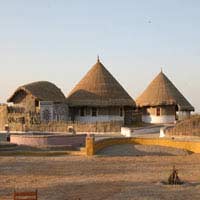 In an attempt to spread nature education and awareness among the Gujarat People, the Forest Department has started many eco-campsites and orientation centers to give knowledge on local flora and fauna and encourage oneness with nature. These Ecotourism in Gujarat sites include the kilad, Padam Dungri, and Mahal Nature Education Eco-campsites in the Dangs, Ratanmahal Sloth Bear Sanctuary in Panchmahal, jessore Wildlife Sanctuary in Banaskantha, Shoolpaneshwar Wildlife Sanctuary in Narmada, Marine National Park in Jamnagar, and Vijaynagar and Polo Forest in Sabarkantha.
In an attempt to spread nature education and awareness among the Gujarat People, the Forest Department has started many eco-campsites and orientation centers to give knowledge on local flora and fauna and encourage oneness with nature. These Ecotourism in Gujarat sites include the kilad, Padam Dungri, and Mahal Nature Education Eco-campsites in the Dangs, Ratanmahal Sloth Bear Sanctuary in Panchmahal, jessore Wildlife Sanctuary in Banaskantha, Shoolpaneshwar Wildlife Sanctuary in Narmada, Marine National Park in Jamnagar, and Vijaynagar and Polo Forest in Sabarkantha.
Gujarat Challenges
The Gujarat faces various ecological challenges. The various Gujarat Challenges are mainly posed by urbanization and industrialization. Both factors have started to damage natural resources before these ecological zones can regenerate their supplies. Populations in cities use more resources and produce more pollution. People dependent on specific habitats like the grasslands also contribute to their reduction. Changes in land-use patterns, decline of grasslands, pressures from increasing cattle, occupation of exotic flora and fauna, desertification and pollution all create threats to Gujarat's ecosystems.
